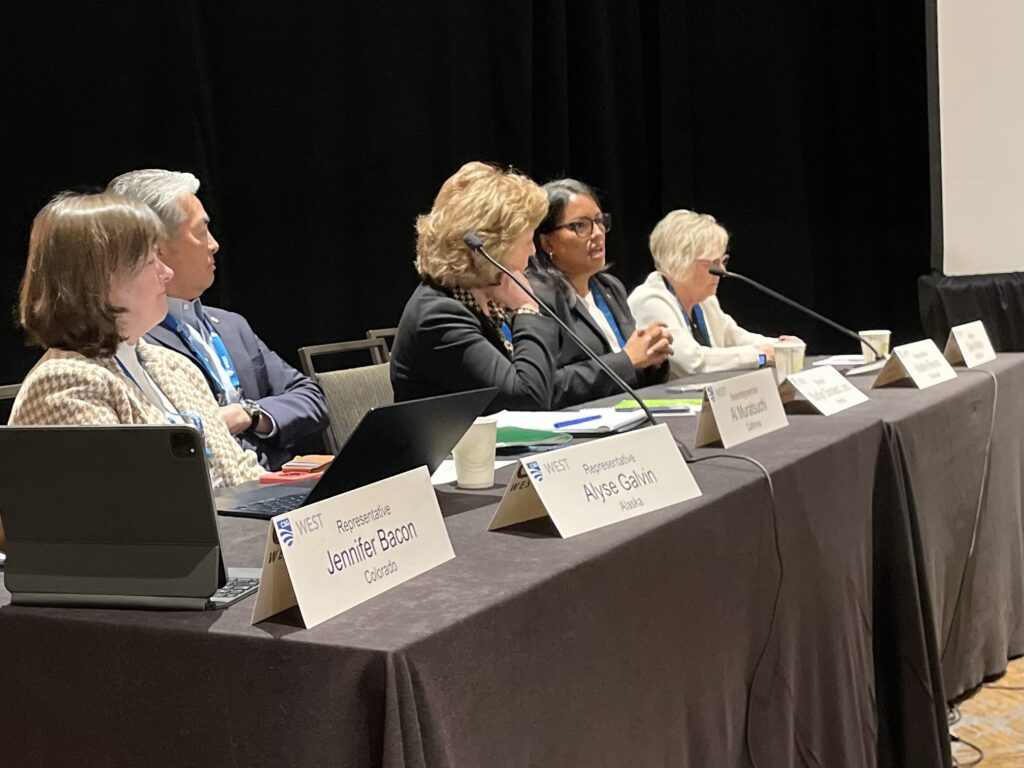Education Committee Recap:
In today’s educational landscape, it is crucial to comprehend the mechanisms that underpin school funding. Presenters Michael Griffith and Justin Silverstein guided audience members through a comprehensive examination of school funding formula structures, including attributes of a high-quality formula, variations in funding across states, and emerging issues in school finance.
Concluding the session, a diverse panel of Western legislators related school funding topics to their respective states and shared challenges, opportunities, and insights.

School Funding 101
Variations in School Funding Sources
The composition of K-12 funding reflects a national average distribution—42.5% local, 44.3% state, and 13.2% federal for the fiscal year 2021-22. Notably, disparities emerge when examining state-level variations, with local funding ranging from 2.0% to 61.7%, state funding from 29.5% to 85.4%, and federal funding from 6.5% to 24.0%.
Notably, disparities emerge when examining state-level variations, with local funding ranging from 2.0% to 61.7%, state funding from 29.5% to 85.4%, and federal funding from 6.5% to 24.0%.
High-Quality Funding Formulas
The core of school funding lies in the formulation of a funding formula where primary and categorical funding sources intersect. High-quality funding formulas aspire to be adequate and equitable but also flexible, adaptable, and predictable. The emphasis on predictability ensures that administrators can anticipate funding changes based on shifts in student populations.
Considerations for Foundation Formulas
Foundation formulas, a prevalent approach, multiply a foundation amount by a weighted student count to determine total funding. This foundation amount varies across states, ranging from $4,015 to $11,525, and can be determined based on research, past expenditures, educational inputs, or the state’s financial capacity. Funding weights are additional resources allocated to high-need student groups like at-risk or special education students. The formula’s final step involves dividing total foundation funding by a district’s ability to pay, yielding state foundation funding.
The widespread adoption of foundation formulas stems from their practicality, offering states and districts an easily adjustable mechanism that balances educational objectives with economic realities. Yet, this adaptability comes with a cautionary note – as policy choices increase, the flexibility available to districts diminishes, emphasizing the delicate balance between standardization and local autonomy in the pursuit of effective school funding.
Emerging Issues in School Funding
Emerging issues in school funding include Costing Out Studies, which determine resources needed for students to meet state standards, and debates on prescriptive targeted funds for special needs populations. Approaches like “professional judgment,” “evidence-based,” “education-cost function,” and “successful school districts” offer varying perspectives and methodologies in implementing these studies.
Professional Judgment Approach
The Professional Judgment Approach relies on educators’ insights, adapting to state standards but lacking a specific tie to current performance outcomes, causing skepticism among stakeholders.
Evidence-Based Approach
The Evidence-Based Approach delves into academic research, creating prototypes reviewed by state-level educators. While research-based, it may lack state-specific context.
Education Cost Function Approach
The Education Cost Function Approach establishes a link between costs and outcomes through state-collected data, requiring high-quality data but offering a strong empirical foundation.
Successful School Districts Approach
The Successful School Districts Approach analyzes resource models of high-performing schools, providing a clear link between costing out results and performance, albeit with limitations on estimating special needs populations.
Multiple Approaches
Using multiple approaches allows triangulation of results and enhanced analysis. Prescriptive Funding Policies involve balancing flexibility and interventions, with some states imposing guardrails and specific requirements, such as Nevada and Maryland. At-Risk/Poverty Counts have evolved, with direct certification and census block data gaining prominence to identify students’ needs accurately. The landscape reflects a complex interplay of methodologies and policies aimed at ensuring equitable and effective school funding.

Legislator Panel on School Funding
| Alaska Representative Alyse Galvin Member, House Finance Committee |
| California Assemblymember Al Muratsuchi Chair, Assembly Committee on Education |
| Nevada Senator Marilyn Dondero Loop Chair, Senate Finance Committee |
| Washington Representative Kristine Reeves Co-Sponsor, HB 1436, Funding Special Education |
| Washington Senator Claire Wilson Chair, Senate Human Services Committee Vice-Chair, Senate Early Learning & K-12 Education Committee |

Adequately Funding Institutional Education
Among the many topics highlighted, Senator Claire Wilson discussed efforts to fund institutional education within Washington’s juvenile justice system. Acknowledging historic K-12 investments following the state’s 2018 McCleary decision, she conversely described a critical lack of funding for justice-involved youth students.
Notably, Senator Wilson shared that most students in Washington’s institutional facilities qualify for an Individualized Education Program (IEP), therefore necessitating special education services.
As co-chair of Washington’s Joint Select Committee on Governance and Funding for Institutional Education, Wilson detailed current and upcoming committee work to address shortfalls in institutional funding. The committee is tasked with examining and evaluating revisions to statutes, funding formulas, funding sources, and operating and capital budget appropriation to assign delineated basic education responsibilities to the Office of the Superintendent of Public Instruction. With a special focus on adequately funding juvenile justice students, the Select Committee will be reporting back to the Governor and the Legislature by December 1, 2024.
Teacher Retention and Inflationary Challenges
Representative Alyse Galvin described Alaska’s teacher retainment challenges, contending that reinstatement of a defined benefit retirement program would support enhanced retention. Following the state’s switch from defined benefits to a defined contribution, Representative Galvin asserted that significant numbers of educators complete their training years in Alaska, then transfer their portable retirement account to a new state for further career building.
Representative Galvin also highlighted the inflationary impact on Alaska’s K-12 funding. She provided data illustrating the Base Student Allocation (BSA) from fiscal years 2012-2023, in which the BSA of $5,930 in FY23 has a FY12 value of $4,776 when adjusted for inflation. With the actual 2012 BSA of $5,680, Representative Galvin emphasized the added strain inflation has placed on current resource allocation, asserting that education budget considerations must reflect rising costs.
At the centerpiece of her comments, Representative Galvin maintained that building greater “trust” among the legislature, executive branch, school districts, and educators is paramount for effectively funding student education.